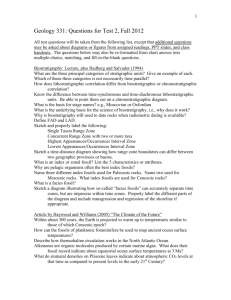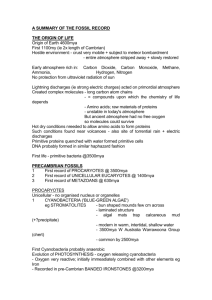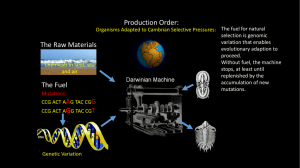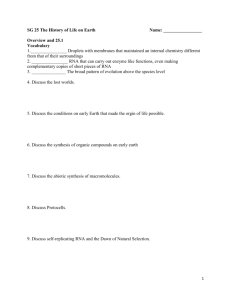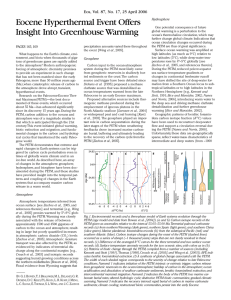Questions for Test 2, Fall 2014
advertisement
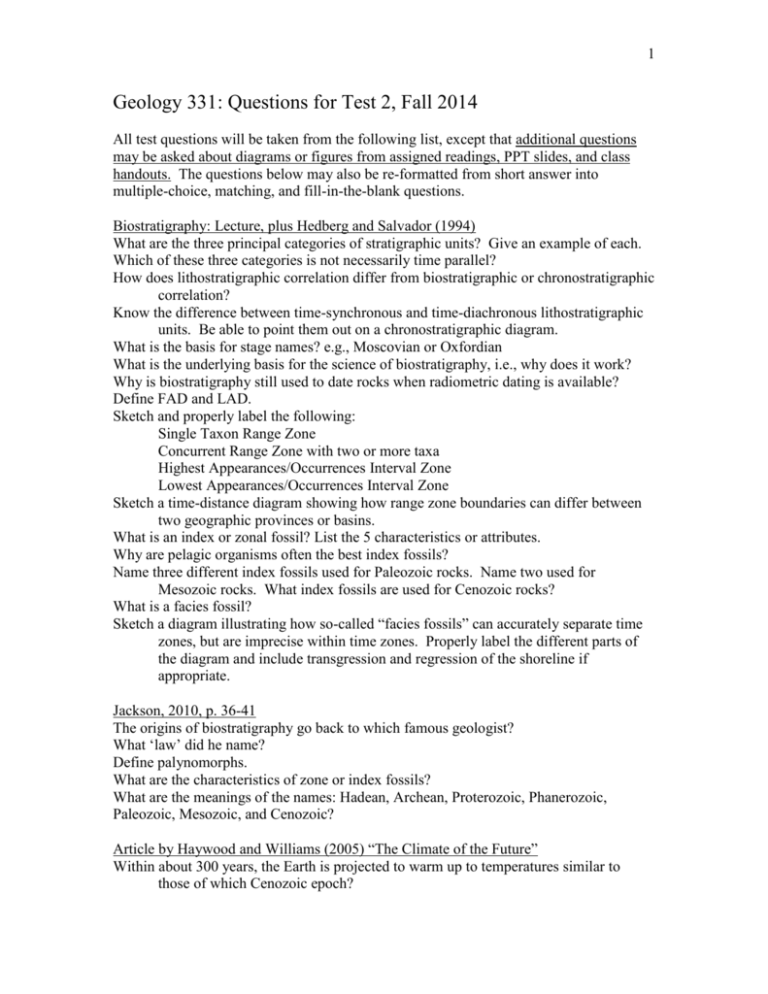
1 Geology 331: Questions for Test 2, Fall 2014 All test questions will be taken from the following list, except that additional questions may be asked about diagrams or figures from assigned readings, PPT slides, and class handouts. The questions below may also be re-formatted from short answer into multiple-choice, matching, and fill-in-the-blank questions. Biostratigraphy: Lecture, plus Hedberg and Salvador (1994) What are the three principal categories of stratigraphic units? Give an example of each. Which of these three categories is not necessarily time parallel? How does lithostratigraphic correlation differ from biostratigraphic or chronostratigraphic correlation? Know the difference between time-synchronous and time-diachronous lithostratigraphic units. Be able to point them out on a chronostratigraphic diagram. What is the basis for stage names? e.g., Moscovian or Oxfordian What is the underlying basis for the science of biostratigraphy, i.e., why does it work? Why is biostratigraphy still used to date rocks when radiometric dating is available? Define FAD and LAD. Sketch and properly label the following: Single Taxon Range Zone Concurrent Range Zone with two or more taxa Highest Appearances/Occurrences Interval Zone Lowest Appearances/Occurrences Interval Zone Sketch a time-distance diagram showing how range zone boundaries can differ between two geographic provinces or basins. What is an index or zonal fossil? List the 5 characteristics or attributes. Why are pelagic organisms often the best index fossils? Name three different index fossils used for Paleozoic rocks. Name two used for Mesozoic rocks. What index fossils are used for Cenozoic rocks? What is a facies fossil? Sketch a diagram illustrating how so-called “facies fossils” can accurately separate time zones, but are imprecise within time zones. Properly label the different parts of the diagram and include transgression and regression of the shoreline if appropriate. Jackson, 2010, p. 36-41 The origins of biostratigraphy go back to which famous geologist? What ‘law’ did he name? Define palynomorphs. What are the characteristics of zone or index fossils? What are the meanings of the names: Hadean, Archean, Proterozoic, Phanerozoic, Paleozoic, Mesozoic, and Cenozoic? Article by Haywood and Williams (2005) “The Climate of the Future” Within about 300 years, the Earth is projected to warm up to temperatures similar to those of which Cenozoic epoch? 2 How can the fossils of planktonic foraminifera be used to map ancient ocean surface temperatures? Describe how thermohaline circulation works in the North Atlantic Ocean. Alkenones are organic molecules produced by certain marine algae. What does their fossil record indicate about equatorial ocean surface temperatures at 3 Ma? What do stomatal densities on Pliocene leaves indicate about atmospheric CO2 levels at that time as compared to present levels in the early 21st Century? Why was the Pliocene warmer than today, and what was the North Atlantic thermohaline circulation like at that time? PETM – Paleocene-Eocene Thermal Maximum: Lecture plus Kunzig (2011) When did the PETM occur? Approximately how long did it last? What happened? What does the Carbon Isotope Excursion show at the PETM? What were possible sources of the massive carbon release at this time? Approximately 4.5 trillion tons of carbon was released during the PETM. How does that amount of carbon compare to what is happening in today’s world? How much did the planet warm? Were there any significant glaciers during the Eocene? Explain your answer. How do values of C13 in fossils and sediments respond to increased amounts of organic carbon released into the environment? Why does organic carbon have negative C13 values relative to marine carbonates? How did ocean chemistry change during the PETM? What happened to carbonate minerals in the oceans during the PETM? What happened to mammals on land during the PETM? How did the PETM influenced the evolution and biogeography of primates? Why did some mammals shrink in size during the PETM? Were there mass extinctions among animals on land during the PETM? Give a yes or no answer and explain your reasons. Explain why the PETM is a geological confirmation of the greenhouse theory. How was carbon removed from the atmosphere allowing the Earth to cool down after the PETM? Explain this quote from the National Geographic article (Kunzig, 2011): “If we continue down this road, there really is no uncertainty. We’re headed for the Eocene. And we know what that’s like.” Ediacaran fossils and the Cambrian Explosion of Life (DK, p. 60-79) When was the Ediacaran or Vendian Period? Give information in both millions of years, and position on the relative geologic time scale. Describe the kinds of animals typically found in the Ediacaran. In terms of tissue layers, what kind of animals were dominant during the Ediacaran? When did the Cambrian begin? What marks the base of the Cambrian? In terms of tissue layers, what kind of animals participated in the Cambrian Explosion of Life? In terms of tissue layers, what kind of animals were responsible for shallow horizontal surficial trace fossils in the Ediacaran? 3 In terms of tissue layers, what kind of animals were responsible for large burrowing trace fossils first found at the base of the Cambrian? Explain why. What geologic formation(s) or fauna is famous for documenting the Cambrian Explosion? Approximately how many of the known animal phyla are represented in the Cambrian? What is the significance of apparently extinct phyla found in the Cambrian? Give an example of a Cambrian fossil that may represent an extinct phylum. What are the two main divisions of the triploblastic animals? How does their larval development differ? Which division contains our own phylum? Why are developmental control (Hox) genes thought to be important in understanding the mechanism of the Cambrian Explosion of Life? What do Hox genes indicate about homologies between various phyla? Was the “Cambrian Explosion of Life” a true explosion of new phyla, or was there a “slow fuse”? Explain your answer. Why is the Burgess Shale so important for understanding Cambrian life? Describe the taphonomy of the Burgess Shale. What does the Burgess Shale tell us about the evolutionary history of Cambrian phyla? Jackson, 2010, p. 42-50 What is a ‘Fossil Lagerstätte’? What is the difference between a ‘Concentration Lagerstätte’ and a ‘Conservation Lagerstätte’? What are obrution deposits? Give the name and geologic age of a Lagerstätte deposit other than the Burgess Shale and Ediacaran biota. What is unique about the deposit you chose to name? Trace Fossils and Prothero (2004) What are the three primary characteristics of trace fossils discussed in lecture? Define the difference between tracks, trails, burrows, and borings. Where would you find trace fossils preserved as epireliefs? Where would you find trace fossils preserved as hyporeliefs? What are the six primary behaviors recorded by trace fossils? What is bioturbation? What is an ichnofacies? Arrange the following marine ichnofacies in correct order from shallow to deep water: Cruziana, Zoophycus, Skolithos, Nereites. What does the ichnofabric index measure?

